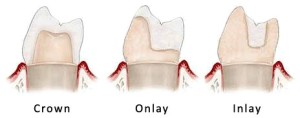Tooth breakage is among the most rampant conditions nowadays. Those who experience this typically encounter tooth trauma or accident caused by a myriad of reasons, including mishaps on any outdoor activities.
No matter how you find tooth breakage severe, dentists who work in emergency dental hospital will always help you overcome it. One therapy you can run to is dental onlay.
A dental onlay is a dental restorative treatment used to fill and restore your teeth. This is an alternative that falls in between a filling procedure and dental crown. Unlike typical filling materials, onlays don’t rely on dental crown. Therefore, your dentist can finish and address your crack or chipped issues without the help of dental crown procedure. Unlike other filling materials, dental onlays can cater large cavities. Dentists often used this after your chewing teeth experienced cavities.
Dental onlay is an effective restorative therapy, just like dental inlay. While dental inlays only work to fill the cusps’ space, dental onlays cover the entire surface of the tooth or cusp. This is why dental professionals sometimes called this as partial crowns. Unlike the traditional dental fillings, dental onlays are much more durable. Therefore, this lasts longer compared to other filling materials. Nonetheless, an onlay’s durability will depend on the type of material you choose. Depending on your budget and preferred aesthetic, dental onlays are available in three common types: gold, porcelain and composite resin.
As outlined by research, dental onlays can last to 30 years! When treated with proper dental care, like good oral hygiene, dental onlays can be the most efficient and excellent restoration for your teeth. Hence, brush and floss your dental onlays daily to keep the bacteria and tooth decay at bay.
There are two different types of dental restorations: direct and indirect. Direct onlay restorations are for those who prefer onlays made inside the dental office while indirect onlays are on a dental laboratory. For first timers, here are the procedures involved in indirect and direct dental onlays.
The indirect dental onlay procedure, during the first appointment, necessitates your dentist to prepare your tooth through removing the tooth decay. Once removed, an impression comes next which needs a dental lab process. Since this will take weeks, you should wait before the custom-made onlay comes out. With this, you will need to wear a temporary filling first until the scheduled second visit arrives. On the contrary, direct dental onlays require your dentist to prepare your tooth, too, similar with indirect onlay process. However, your dentist will use composite resin material to fill your tooth. Unlike the traditional direct onlay, modernized direct onlays only require one visit. Thanks to CEREC. This is a 3D computer imagery process that can produce customized restoration in one dental visit!
Regardless of what type you choose, dental onlays really are beneficial. However, be sure you do it with a professional one. The success of your treatment relies to the hands and expertise of your dentists.
